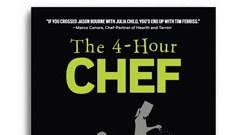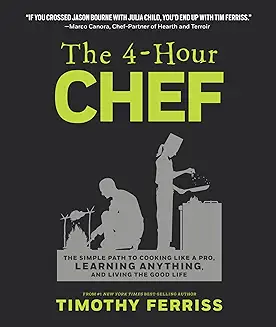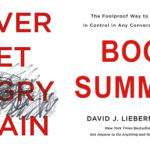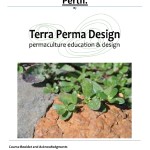Book, Movie & Documentary Recommendations from The 4-Hour Chef
Notes: (Just look at the contents below to get an idea of the summary.)
First things first… I’ve not even reached halfway through the book and I feel like it’s like the kitchen section of the Argos catalogue with stories that are mostly entertaining but also not very much to the point with more references to product placement, link placement, other stories, etc. Hats off to Tim for doing so much though, he really goes all the way. Stuff I still need to google: The Von Restorff or navel pop-out effect. Consonant system mnemonic or major system. Loci system or memory palace technique.
His timeline of culinary interest start with eating crickets a la front yard, go on to him try and giving up a few times and end with him cooking all sorts especially roasting crickets.
Interesting quotes before chapters, sections and recipes and good old music recommendations to listen to while cooking/eating.
2 principles- failure points (too many Ingredients etc) and margin of safety (pick a recipe that comes out great even if you mess up).
The DiSSS (Deconstruct, select, sequence, stakes) and CaFE (Compression, frequency, encoding) method of learning anything (see video below or google it).
Backward, upside down or reverse fire better than teepee method and you can use the same words to google anything else you want to deconstruct.
12 sentences is all you need. Deconstructing a dozen sentences can uncover the soul of a language. Finding helping/auxiliary verbs will help fast track learning a language.
Cooking has 3 ‘verbs like that’ which will help. In order of earliest wins first – braising, sautéing, grilling. Using MED (Minimal effective dose) cut out as many steps and ingredients as possible maybe replacing with fewer but better ingredients.
Even if you never cook, smelling your food before eating will change your experience with flavour. If you eat something chilli it’s best to have something with fats as it’s more soluble. He tried the Indian combo of cayenne powder on mango and suggest olive oil on chocolate ice cream.
MED – Minimal effective dose! Always!
Lots and lots of fluff but it’s entertaining. Different geniuses stories, ways of learning, tricks, hacks, etc.
Want to learn fast start backwards. What were the key bits successful people did towards the end and go back. What are the commonalities that are not being taught and which of these neglected ones can you get really good at really quick.
Making effective decisions required massive elimination of options.
Use a probe thermometer for everything. Almost all veggies are done when you can slide a fork in (held between thumb and forefinger). 180 degrees C for everything and for protein 60 degrees C.
DON’T USE INCOMPLETE INFORMATION AS AN EXCUSE FOR INACTION!
Using your palm as reference to raw, medium and well done.

Use sherry instead of balsamic vinegar as the latter is fake. Real balsamic vinegar ages for decades, in barrels and different woods etc etc.
Cook meats 2 minutes each side on medium or higher heat.
When on the table make ok sign with both hands and the one that looks like a ‘b’ is where your bread is (left) so ‘d’ is where your drink will be (right). Also remember left has 4 letters which matches fork while right has 5 letters for knife and spoon.
It’s not cooking it’s prep – things you can do days or hours ahead.
Rules of behavioural change:
1 – Make it small and temporary.
2 – Make it measurable and a game.
3 – Make it competitive.
4 – Take pictures of it all.
5 – In the beginning, focus on convenience.
Basically the ‘what gets measured, gets managed’ rule.
If something feels like it’s missing in food it’s probably acid so keep lemons at hand.
Anti-angiogenesis tea – white tea (dragon pearl jasmine) and green tea (Japanese sencha) are recommended to fight cancer with Earl Grey coming in second. Including foods rich in Vitamin K2, they also reduce men’s prostate cancer by 50%, have cooked tomatoes 2-3 times a week.

Pan shaker is a derogatory term for someone who pokes and shuffles unnecessarily while cooking, good for TV chefs only.
Placing fruit in a paper bag helps to concentrate the levels of ethylene gas which is what helps induce ripening (bananas/avocados, etc.).
Aztec word for avocado, ahuacatl, means “testicle”.
Saurkraut special: Things rot when exposed to air. But if you protect food from air, making the environment anaerobic, quite a few goodies ferment instead and become delicious. Sauerkraut is the poster child for this (and also the reason Germans were called “Krauts” during WWII). Unlike most store-bought sauerkraut, which is pasteurised and devoid of bacteria (unless the label says “raw” or “naturally fermented” and is found in the refrigerated section), our homemade version will be loaded with, for lack of a better term, “good” bacteria. There are an estimated 10 times more bacterial cells in your body than human cells: 100 trillion of them to 10 trillion of you. These 100 trillion stowaways have been nicknamed the “microbiome.” The two primary strains of bacteria so far identified that influence fat absorption are Bacteroidetes and Firmicutes. Lean people have more Bacteroidetes and fewer Firmicutes; obese people have more Firmicutes and fewer Bacteroidetes. As obese people lose weight, the ratio of bacteria in their guts shifts to favour Bacteroidetes. Given that a strong cycle of antibiotics can leave your microbiome off-kilter for up to four years, I view sauerkraut as a smart investment in immune function and fat-burning capabilities. Still worried about a recipe with bacteria? I wouldn’t be. Fred Breidt, a microbiologist with the United States Department of Agriculture, has never found a single case of sickness from contaminated sauerkraut. It’s the perfect gateway drug for an entire class of hands-off “cooking.”
Bacon and olive oil have the same amount of oleic acid which is praised for and generally considered “heart-healthy”.
Amazon #ads

CONTENTS
INTRO
On the Shoulders of Giants
How to Use This Book
META META-LEARNING
“Bill Gates Walks into a Bar…” The Power of Outliers
DECONSTRUCTION: Exploring the Great Unknown
ASSIGNMENT: Learning to “Taste”
SELECTION: 80/20 and Med
SEQUENCING: The Magic of Proper Ordering
STAKES: The Carrot and the Stickk
COMPRESSION: Cheat Sheets for Anything
FREQUENCY: Cramming Six Months of Culinary School into 48 Hours
ENCODING: Making Slippery Ideas Stick
THE DOMESTIC
Rethinking Recipes
The 80/20 Pantry: All You Need
Top Gear: From Surgical Towels to Big Green Eggs
Lesson Calendar
LESSON 01: Osso “Buko”
LESSON 02: Northeast African (or Middle Eastern) Scrambled Eggs
Slow-Carb Wines: The Top 10 Lists
LESSON 03: Coconut Cauliflower Curry Mash
LESSON 04: Union Square Zucchini
The Vocabulary of Cutting
Introduction to Dim Mak
LESSON 05: Harissa Crab Cakes
LESSON 06: Bittman Chinese Chicken with Bok Choy
LESSON 07: Arugula, Avocado, and Roma Salad
LESSON 08: Sexy-Time Steak
In Search of the Perfect Cup of Coffee
LESSON 09: 9th Meal‒4-Person Dinner Party
LESSON 10: Roasted Garlic and Gazpacho
LESSON 11: Tim’s Top 4 Immersion Sauces: Pick One
LESSON 12: Rock ’N’ Eel
LESSON 13: Sous-Vide Chicken Breast
LESSON 14: Seared Scallops
LESSON 15: Chicken Higado Pâté
OPTIONAL LESSON 16: “MLBJ”
LESSONS 17 & 171/2: The First Hosting Party, The Second Dinner Party
THE WILD
Top Gear Survival: Tarps, Traps, and Tactical Knives
The Importance of Rabbits
The Manual Arts
The Rule of Threes
OPTIONAL LESSON 18: How to Build a Debris Hut
OPTIONAL LESSON 19: Making Drinkable Water
The Anti-Hunter’s First Hunt
The Gun
Top 10 U.S. Hunts According to Steve Rinella
LESSON 20: Vietnamese Venison Burgers and Bagna Cauda
LESSON 21: Sauerkraut
LESSON 22: Sautéed Beef Heart
LESSON 23: Feral Humans and the Golden Gate Buffet
LESSON 24: Kevin’s “Best Pancakes of My Life” Acorn Pancakes
LESSON 25: Muscle CricketTM Protein Bars
The Odd Appeal of Street Quail
LESSON 26: “Street Quail” Catch-and-Release
LESSON 27: Hobo-Can “Hoboken” Cooking
Fishing: From Gill Nets to Yo-Yo Traps
LESSON 28: Ceviche
LESSON 29: Moules Marinière with Fennel
LESSON 30: From Modern to Mallmann
LESSON 31: How to Gut and Cook Tree Rat (Or Fish)
LESSON 32: Sweet Potato Rescoldo
Nose to Tail, A to Z: Learning to Butcher
LESSON 33: How to Butcher a Chicken
LESSON 34: Lobstercide
The Kolkata (Calcutta) Market Incident
LESSON 35: Clambake in a Garbage Can
THE SCIENTIST
A Trip to Seattle
The GNC Gourmet: The Fun of Multipurpose Ingredients
Damage Control: Preventing Fat Gain When You Binge
The Basics: Elementary, My Dear Watson…
The Science of Gels
Crunchy Bloody Mary
Arugula Spaghetti
Balsamic Vinaigrette Pearls
Olive Oil Gummy Bears
The Science of Spherification
Mojito Bubbles
The Science of Emulsification
Champagne Vinaigrette
The Science of Foams
Beet Foam
The Science of Solvents
Bacon-Infused Bourbon
The Science of Powders
Nutella Powder
The Science of Fermentation
Go-Carb Yeast Waffles (or Pancakes)
The Science of Dehydration
The Best Jerky in the World
The Science of Oxidation
How to Chop Wine: Hyperdecanting in 20 Seconds
The Science of Transglutaminase
Tuna and Yellowtail Checkerboard
The Science of the Maillard Reaction
Rosemary Pistachio Cookies
The Science of Pressure Cooking
Caramelized Carrot Soup
The Science of Denaturation
Perfect Poached Eggs
Perfect Beef Short Ribs
The Science of Liquid Nitrogen
30-Second Cocoa-Goldshläger Ice Cream
The Triple Crown of Cheat Day: For the Piggies (in More Ways Than One)
#1 Welcome to the Jungle: The Vermonster
#2 The Turbacon: Sin Against Nature or Meat-Glue Masterpiece?
#3 The NYC Food Marathon: 26.2 Dishes in 26 Locations in 24 Hours
THE PROFESSIONAL
A Tale of Two Cities: New York
The Classics
Soffritto
Helicopter-Blade Pea Soup
Bear Fat (or Not) Fries
The “Hareiller ” Roast Chicken
Brown Butter Plantains
Bistro-Style Bavette Steak
French Omelet
A Tale of Two Cities: Chicago
Avant-Garde
How Grant Creates: 10 Principles
Serviceware
Paraffin Wax Bowls
Almond Za’atar Crackers with Tuna
Reversal
Cauliflower Crème Brûlèe
Technology
“Anti-Griddle ” Peppermint Chocolate Pops
“Bouncing” Flavors
Oyster + Kiwi
Rare Ingredients
Takashi Inoue’s
“Tongue Experience ”
Form Mimicking
Bacon Roses
Edible Dirt Centerpiece
Texture Manipulation: Coconut Meal
Dandelion “Coffee ” with Coconut Milk (Aperitif)
Crisp-Baked Sesame-Coconut Chicken (Entrée)
Coconut Paleo Pops (Dessert)
Profile Replication
Peking Duck Wraps
Themes
National Themes: Brazilian Meal
Hearts of Palm Salad (Appetizer)
Caipiroska Cocktail (Drink)
Feijoada (Entrée)
Ingredient Themes: Sage & Paprika Meal
Kokkari Prawns (Entrée)
The Medicine Man (Digestif)
Sage Gelato (Dessert)
Aroma
Cigar-Infused Tequila Hot Chocolate
Dragonforce Chaconne
Carpe a l’Ancienne
Closing Thoughts—On More Perfect Days
APPENDIX
More Cooking Like a Pro
The Bite-Size World: 193 Recipes, 193 Countries
The Chef Genealogical Charts: An Unofficial Who’s Who (And Who Taught Whom)
Turning Pro Without Culinary School—The Full Training Program
More Learning Anything
How to Shoot a 3-Pointer Within 48 Hours
Guns?!? OMFG, ROFL, MPICIMFP, WTF?!?
Bicycleshop and the $10,000 Challenge: Memorizing a Deck of Cards in 43 Seconds
Nine Must-Know Knots
Building a Fire with a Bow Drill
More Living the Good Life
How to Become a VIP (and Other Tips)
Yelp’s 100 Best Restaurants in the U.S.A.
The Culinary Maps
Acknowledgments
Credits
Conversion Chart
Scorecard





